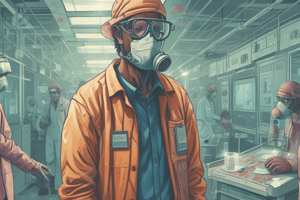Podcast
Questions and Answers
What is the primary goal of genomics in disease control?
What is the primary goal of genomics in disease control?
- To prove immunity due to past infection or vaccination
- To cultivate pathogens directly
- To characterize pathogens and help control the disease they cause (correct)
- To reduce the analytical error in immune assays
What is the primary advantage of laboratory automation?
What is the primary advantage of laboratory automation?
- It increases the analytical error in immune assays
- It helps in cultivating pathogens directly
- It is essential for indirect diagnosis
- It reduces the time and increases the throughput of samples (correct)
What is the first antibody to appear in most patients after exposure?
What is the first antibody to appear in most patients after exposure?
- IgE
- IgM (correct)
- IgA
- IgG
What is the primary application of WGA in SARSCov-2 surveillance?
What is the primary application of WGA in SARSCov-2 surveillance?
What is the primary purpose of serodiagnosis?
What is the primary purpose of serodiagnosis?
What is syndromic testing used for?
What is syndromic testing used for?
What is multiplex PCR used for?
What is multiplex PCR used for?
What is the benefit of using ELISA in immune assays?
What is the benefit of using ELISA in immune assays?
What is the primary limitation of syndromic testing?
What is the primary limitation of syndromic testing?
What is the primary advantage of indirect diagnosis?
What is the primary advantage of indirect diagnosis?
What is the primary reason for diagnosing an infection?
What is the primary reason for diagnosing an infection?
What is the purpose of infection control in relation to diagnosis?
What is the purpose of infection control in relation to diagnosis?
What type of sample can be collected for laboratory tests?
What type of sample can be collected for laboratory tests?
Why is it essential to minimize specimen contamination during collection?
Why is it essential to minimize specimen contamination during collection?
What is the importance of collecting sufficient quantity of specimens?
What is the importance of collecting sufficient quantity of specimens?
Why is it essential to determine the type of infection?
Why is it essential to determine the type of infection?
What is the primary purpose of Matrix-assisted laser desorption/ionization time of flight (MALDI-TOF)?
What is the primary purpose of Matrix-assisted laser desorption/ionization time of flight (MALDI-TOF)?
What is the process by which protein molecules are converted into ions in the gas phase in MALDI-TOF?
What is the process by which protein molecules are converted into ions in the gas phase in MALDI-TOF?
What is the principle behind the measurement of time of flight in MALDI-TOF?
What is the principle behind the measurement of time of flight in MALDI-TOF?
What is the primary role of the matrix solution in MALDI-TOF?
What is the primary role of the matrix solution in MALDI-TOF?
What is the primary advantage of using MALDI-TOF for microbial identification?
What is the primary advantage of using MALDI-TOF for microbial identification?
What is the primary limitation of colony and cellular morphology in microbial identification?
What is the primary limitation of colony and cellular morphology in microbial identification?
What is the primary advantage of using serology in diagnostic methods?
What is the primary advantage of using serology in diagnostic methods?
What is the primary application of genomics in disease control?
What is the primary application of genomics in disease control?
What is the primary advantage of multiplex PCR?
What is the primary advantage of multiplex PCR?
What is the primary goal of syndromic testing?
What is the primary goal of syndromic testing?
What is the primary limitation of syndromic testing?
What is the primary limitation of syndromic testing?
What is the primary role of IgM in immune assays?
What is the primary role of IgM in immune assays?
What is the most suitable diagnostic test for a 26-year-old teacher who has been in contact with a measles case at school?
What is the most suitable diagnostic test for a 26-year-old teacher who has been in contact with a measles case at school?
What is the significance of a negative Measles IgM and a positive Measles IgG result in the teacher?
What is the significance of a negative Measles IgM and a positive Measles IgG result in the teacher?
What type of sample is required to diagnose a sore throat caused by Streptococcus pyogenes?
What type of sample is required to diagnose a sore throat caused by Streptococcus pyogenes?
What is the characteristic of Streptococcus pyogenes growth on blood agar?
What is the characteristic of Streptococcus pyogenes growth on blood agar?
What is the appropriate antibiotic choice for treating pharyngitis caused by Streptococcus pyogenes?
What is the appropriate antibiotic choice for treating pharyngitis caused by Streptococcus pyogenes?
What is the significance of a positive Lancefield group A result in a throat swab?
What is the significance of a positive Lancefield group A result in a throat swab?
What is essential when collecting specimens for microbiologic examination?
What is essential when collecting specimens for microbiologic examination?
What is the purpose of selective media in microbiologic diagnosis?
What is the purpose of selective media in microbiologic diagnosis?
Which of the following is a direct diagnosis method?
Which of the following is a direct diagnosis method?
What is a key consideration when diagnosing infections in the lab?
What is a key consideration when diagnosing infections in the lab?
What is an additional step in microbial identification?
What is an additional step in microbial identification?
What is the purpose of antimicrobial susceptibility testing?
What is the purpose of antimicrobial susceptibility testing?
The GI tract is essentially a long ______, ascending from the mouth to the anus.
The GI tract is essentially a long ______, ascending from the mouth to the anus.
The GI tract is heavily colonised with ______ and viruses and encounters millions of new ones every day.
The GI tract is heavily colonised with ______ and viruses and encounters millions of new ones every day.
All intestinal surfaces are coated with layers of ______, which provides mechanical protection.
All intestinal surfaces are coated with layers of ______, which provides mechanical protection.
The muscular surfaces of the GI tract ensures movement termed ______.
The muscular surfaces of the GI tract ensures movement termed ______.
Various fluids in the GI tract also have ______ properties.
Various fluids in the GI tract also have ______ properties.
Normal ______ is also vitally important to prevent infection.
Normal ______ is also vitally important to prevent infection.
The respiratory system is the most commonly infected ______ system.
The respiratory system is the most commonly infected ______ system.
Health care providers will see more respiratory infections than any other type of ______.
Health care providers will see more respiratory infections than any other type of ______.
The respiratory tract is divided into two ______ tracts: upper and lower.
The respiratory tract is divided into two ______ tracts: upper and lower.
The upper respiratory tract includes the ______, sinuses, pharynx, and larynx.
The upper respiratory tract includes the ______, sinuses, pharynx, and larynx.
Respiratory pathogens can be transmitted from human to human and can ______ within a community.
Respiratory pathogens can be transmitted from human to human and can ______ within a community.
Some respiratory pathogens exist as part of the normal ______ flora.
Some respiratory pathogens exist as part of the normal ______ flora.
The respiratory viruses that most commonly circulate in all continents as endemic or epidemic agents are ______ virus and others.
The respiratory viruses that most commonly circulate in all continents as endemic or epidemic agents are ______ virus and others.
Respiratory Syncytial Virus is an ______ RNA virus and belongs to the Paramyxoviridae family.
Respiratory Syncytial Virus is an ______ RNA virus and belongs to the Paramyxoviridae family.
The very young (under ______ year of age) and the elderly are at the greatest risk of developing severe disease.
The very young (under ______ year of age) and the elderly are at the greatest risk of developing severe disease.
Diagnosis is typically made via ______-transcription real-time PCR (RNA) or RT-PCR (DNA).
Diagnosis is typically made via ______-transcription real-time PCR (RNA) or RT-PCR (DNA).
Children born prematurely, or with underlying ______ lung disease, are also at increased risk of developing severe disease.
Children born prematurely, or with underlying ______ lung disease, are also at increased risk of developing severe disease.
Monitored by UKHSA, outbreaks of seasonal ______/Influenza occur every year.
Monitored by UKHSA, outbreaks of seasonal ______/Influenza occur every year.
Lower respiratory tract infection can be caused by a virus or so-called ‘atypical’ bacteria, including ______ pneumoniae.
Lower respiratory tract infection can be caused by a virus or so-called ‘atypical’ bacteria, including ______ pneumoniae.
Nosocomial pneumonia usually occurs approximately ______ hours after admission to hospital.
Nosocomial pneumonia usually occurs approximately ______ hours after admission to hospital.
Aspiration pneumonia is a major problem in ______ patients.
Aspiration pneumonia is a major problem in ______ patients.
Community-acquired pneumonia usually presents as a ______ pneumonia.
Community-acquired pneumonia usually presents as a ______ pneumonia.
Staphylococcus aureus is usually associated with ______ pneumonia.
Staphylococcus aureus is usually associated with ______ pneumonia.
Fluid losses of nearly 1 litre per hour have been reported in severe cases of a disease, and an untreated patient can lose up to 50% of ______ during the course of the disease.
Fluid losses of nearly 1 litre per hour have been reported in severe cases of a disease, and an untreated patient can lose up to 50% of ______ during the course of the disease.
Don’t forget about ______-2 in lower respiratory tract infections.
Don’t forget about ______-2 in lower respiratory tract infections.
The voided fluid contains flecks of ______, giving the description of ‘rice-water stool’.
The voided fluid contains flecks of ______, giving the description of ‘rice-water stool’.
______ Spp Thioshulphate citrate bile salts (TCBS) Agar is used for the selective isolation of cholera vibrios and Vibrio parahaemolyticus from a variety of clinical and nonclinical specimens.
______ Spp Thioshulphate citrate bile salts (TCBS) Agar is used for the selective isolation of cholera vibrios and Vibrio parahaemolyticus from a variety of clinical and nonclinical specimens.
Clostridium difficile is a Gram-positive, ______ rod-shaped bacterium found as part of the normal intestinal biota.
Clostridium difficile is a Gram-positive, ______ rod-shaped bacterium found as part of the normal intestinal biota.
The predominant symptoms of C. difficile is ______, with abdominal cramps, fever and leucocytosis in more severe cases.
The predominant symptoms of C. difficile is ______, with abdominal cramps, fever and leucocytosis in more severe cases.
Gastritis is experienced as a sharp or burning ______ emanating from the upper abdomen.
Gastritis is experienced as a sharp or burning ______ emanating from the upper abdomen.
Flashcards are hidden until you start studying




